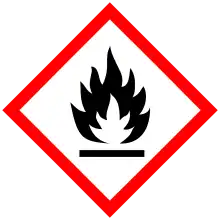 | |
 | |
| Names | |
|---|---|
| IUPAC name
Tetrasilane | |
| Other names
n-Tetrasilane | |
| Identifiers | |
3D model (JSmol) |
|
| ChemSpider | |
| ECHA InfoCard | 100.132.456 |
| EC Number |
|
PubChem CID |
|
| UNII | |
CompTox Dashboard (EPA) |
|
| |
| |
| Properties | |
| H10Si4 | |
| Molar mass | 122.420 g·mol−1 |
| Appearance | colourless liquid that self ignite in air[1] |
| Density | 0.792 g·cm−3[2] |
| Melting point | −89.9 °C[2] |
| Boiling point | 108.1 °C[2] |
| reacts[1] | |
| Hazards | |
| GHS labelling: | |
 | |
| Danger | |
| H250 | |
| Related compounds | |
Related compounds |
butane |
Except where otherwise noted, data are given for materials in their standard state (at 25 °C [77 °F], 100 kPa).
Infobox references | |
Tetrasilane is a silane with the structure formula SiH3–(SiH2)2–SiH3. It is the silane analog of butane.
Preparation
Tetrasilane can be prepared by reacting magnesium silicide (Mg2Si) with acids like 20% phosphoric acid in 50–60 °C.[3]
The reaction can produce silanes up to n=15. The reaction of magnesium silicide with 25% hydrochloric acid produces 40% monosilane, 30% disilane, 15% trisilane, 10% tetrasilane and 5% higher silanes.[4] The mixture can be separated by fractional distillation.
In addition, higher silanes can also be obtained by discharges monosilane:[3]
Properties
Tetrasilane is a colourless, pyrophoric liquid that has a disgusting odour. Even below 54 °C, it will still spontaneous combust.[1] It is even more unstable than trisilane, slowly decomposing at room temperature, releasing hydrogen and forming shorter chain silanes.[5]
Reactions
Photochemical disproportionation of tetrasilane will produce 3-silylpentasilane and disilane.[6]
With the presence of aluminium chloride, heating tetrasilane in xylene will allow isomerization to isotetrasilane.[7]
References
- 1 2 3 Material Safety Data Sheet for Tetrasilane (Si4H10) (PDF-Datei)
- 1 2 3 Lide, D. R., ed. (2005). CRC Handbook of Chemistry and Physics (86th ed.). Boca Raton (FL): CRC Press. p. 81. ISBN 0-8493-0486-5.
- 1 2 Ralf Steudel (2014), [, p. 294, at Google Books Chemie der Nichtmetalle: Synthesen - Strukturen - Bindung – Verwendung] (in German), De Gruyter, pp. 294–295, ISBN 978-3-11-030797-9
{{citation}}: Check|url=value (help) - ↑ Egon Wiberg (2011), [, p. 320, at Google Books Lehrbuch der Anorganischen Chemie: Mit einem Anhang: Chemiegeschichte] (in German), Walter de Gruyter, pp. 319–320, ISBN 978-3-11-023832-7
{{citation}}: Check|url=value (help) - ↑ Alfred Stock, Paul Stiebeler, Friedrich Zeidler (1923-07-04), "Siliciumwasserstoffe, XVI.: Die höheren Siliciumhydride", Berichte der Deutschen Chemischen Gesellschaft (in German), vol. 56, no. 7, pp. 1695–1705, doi:10.1002/cber.19230560735
{{citation}}: CS1 maint: multiple names: authors list (link) - ↑ F. Fehér, I. Fischer (March 1976), "Beiträge zur Chemie des Siliciums und Germaniums, XXVIII. Die photochemische Disproportionierung von n-Tetrasilan, Darstellung und Eigenschaften von 3-Silylpentasilan", Zeitschrift für anorganische und allgemeine Chemie (in German), vol. 421, no. 1, pp. 9–14, doi:10.1002/zaac.19764210103
- ↑ Franz Fehér, Franz Ocklenburg und Dieter Skrodzki: Beiträge zur Chemie des Siliciums und Germaniums, XXXII, Isomerisierung von höheren Silanen mit Aluminiumchlorid. In: Zeitschrift für Naturforschung B. 35, 1980, S. 869–872 (PDF, freier Volltext).